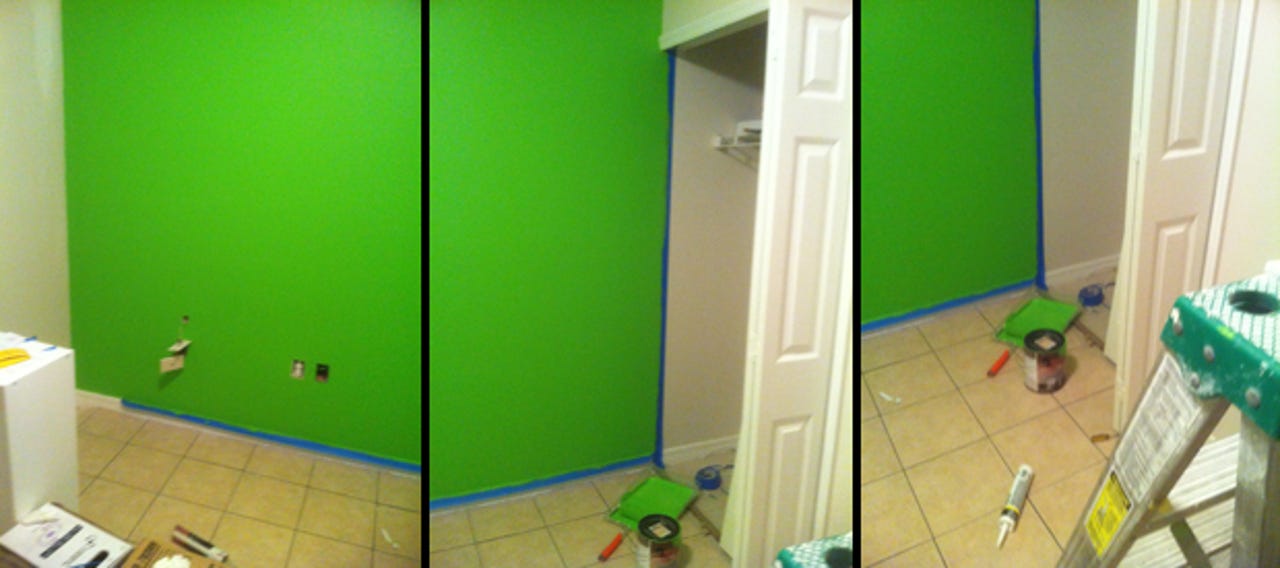Getting started with green screen (Skype Studio project)

This article is a continuation of our DIY-IT Skype Studio series. In this article, I'll look at the first step in creating a green screen in the studio: painting a wall green. We'll start with some example video clips, plus you'll see a clip of my disembodied head. No, really.
Read what's already been published on our DIY-IT Skype Studio series:
- Building a broadcast-quality video studio for Skype in a 10×9 foot space
- Finding a camcorder that works with Skype is harder than you might expect
Here's an example of what you can do with green screen:
Now, the idea of green screen is that the chroma key software subtracts out any part of the video that it recognizes as the key color, and lets you substitute in something different. As it turns out, though, the BoinxTV software I'm using is quite aggressive at color matching, and so a lime green T-shirt also got the green screen treatment in an earlier test.
Here's a rather silly demo of where you can go with this, if you lose all self-control:
Finding the paint
So, let's start with the basics: a wall. I decided to use the wall that was farthest into the room as the green screen. Rather than using cloth or trying to do something temporary, the easiest (and highest-quality) approach was to paint it.
While there may, in fact, be "official" green screen paint, I decided to go the low-tech way and use a Disney paint color. Seriously.
I found somewhere on the Web a mention that someone had used Disney's Sonic Boom paint with excellent green screen results. Sadly, I can't find the link, or I'd share the link love. In any case, as a new home owner, I had no idea how one goes about buying paint, so I went a little nuts in the process.
It turns out, you can't just order paint online. It also turns out that you can't just go to the store and pick paint cans up off the shelf. So if you go online to Home Depot's or Lowes' Web site, you're going to see all sorts of unsatisfactory strange indications when looking for "Sonic Boom Disney" paint.
Here's the secret. Paint isn't shipped to stores in cans of color. Instead, the paint companies sell white. That's it. White. When you go to the store and specify something like "Behr 1754 Premium plus ultra interior flat medium base tinted with DC4B-40-5 Sonic Boom Disney" (which is what I did), they somehow mix up a batch of it for you, right there, while you wait.
Somewhere at Behr paints, there is a very patient technical support woman who talked me through all this. I'd reached a boiling point trying to figure out how to find this stuff, and finally I decided to call the company. Paint companies also have tech support people and one very nice and extremely patient woman explained the paint facts of life to me.
Preparing the wall
Next up, you need to prepare the wall. We used a professional painter (man's gotta know his limitations!), and the first thing he did was clean and prep the wall (fill the holes and sand, like for any painting job).
He then put blue tape around the various edges, to protect the floor, ceiling, and other walls from the paint. Here's a picture that shows three views of the room with some of the tape removed:
By the way, notice all the tile. This became part of my ongoing "interesting" sound problem, which I'll talk about in the next article in this series.
According to my savior over at Behr Paints, a gallon covers about 350 square feet (in one coat). She recommended doing two coats. The first coat will look a little mottled and will serve as the primer. She then recommended we wait at least four hours and no more than two weeks before doing the second coat. The second coat is the finish coat. Nothing needs doing after that.
We followed her instructions to the letter and the green screen wall came out perfectly.
Cost
Carrie Specht, fellow Internet Press Guild member and creator of ClassicFilmSchool.com pointed out that low budget indie filmmakers like to know about costs.
The gallon of paint cost me $30.98 plus tax at the local Home Depot. As for the painter, I don't have an exact number since that work was part of a much larger project, but the cost to paint just one wall wasn't all that much -- certainly compared to what it would have cost to undo my mistakes.
Stay tuned... more Skype Studio secrets to come in future articles.
